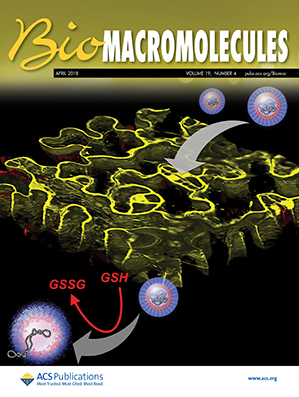Poly(2-(diethylamino)ethyl methacrylate)-Functionalized Carbon Nanodots as Theranostic Platforms for siRNA Delivery and Survivin Silencing in Triple-Negative Breast Cancer
IF 5.5
2区 化学
Q1 BIOCHEMISTRY & MOLECULAR BIOLOGY
引用次数: 0
Abstract
This study describes the development of carbon nanodot (CDs)-based theranostic nanocarriers that integrate gene silencing with fluorescence imaging. Nitrogen- and sulfur-doped CDs were functionalized through controlled radical surface polymerization of 2-(diethylamino)ethyl methacrylate (DEAEMA), yielding self-tracking, cationic siRNA carriers CDs-pDEAEMA. The functionalization of CDs enhanced their fluorescence, broadening the emission spectrum toward the biologically transparent window. Fluorescent CDs-pDEAEMA effectively bound siRNA, remaining stable under physiological conditions, while in vitro studies proved their hemocompatibility and cytocompatibility on human dermal fibroblasts. Moreover, the ability to deliver BIRC5 siRNA was demonstrated in MDA-MB-231, successfully transfecting triple-negative breast cancer cells and resulting in an 80% reduction in the anti-apoptotic protein survivin. Furthermore, uptake studies demonstrated that the theranostic CDs are efficiently internalized in tumor cells and are clearly detectable by fluorescence imaging in the red region. These findings highlight the potential of CDs-pDEAEMA as an advanced theranostic tool for real-time tracking of siRNA therapy of breast cancer.
- Download: Download high-res image (156KB)
- Download: Download full-size image
聚(2-(二乙胺)甲基丙烯酸乙酯)功能化碳纳米点作为三阴性乳腺癌siRNA递送和Survivin沉默的治疗平台
本研究描述了基于碳纳米点(CDs)的治疗性纳米载体的发展,该载体将基因沉默与荧光成像相结合。通过2-(二乙胺)甲基丙烯酸乙酯(DEAEMA)的可控自由基表面聚合,对氮掺杂和硫掺杂CDs进行了功能化,得到了自跟踪的阳离子siRNA载体CDs- pdeaema。CDs的功能化增强了它们的荧光,扩大了向生物透明窗口的发射光谱。荧光CDs-pDEAEMA能有效结合siRNA,在生理条件下保持稳定,体外研究证实其与人真皮成纤维细胞的血液相容性和细胞相容性。此外,在MDA-MB-231中证明了传递BIRC5 siRNA的能力,成功转染三阴性乳腺癌细胞,导致抗凋亡蛋白survivin减少80%。此外,摄取研究表明,治疗性CDs可以有效地内化在肿瘤细胞中,并且可以通过荧光成像在红色区域清晰地检测到。这些发现突出了CDs-pDEAEMA作为实时跟踪siRNA治疗乳腺癌的先进治疗工具的潜力。
本文章由计算机程序翻译,如有差异,请以英文原文为准。
求助全文
约1分钟内获得全文
求助全文
来源期刊

Biomacromolecules
化学-高分子科学
CiteScore
10.60
自引率
4.80%
发文量
417
审稿时长
1.6 months
期刊介绍:
Biomacromolecules is a leading forum for the dissemination of cutting-edge research at the interface of polymer science and biology. Submissions to Biomacromolecules should contain strong elements of innovation in terms of macromolecular design, synthesis and characterization, or in the application of polymer materials to biology and medicine.
Topics covered by Biomacromolecules include, but are not exclusively limited to: sustainable polymers, polymers based on natural and renewable resources, degradable polymers, polymer conjugates, polymeric drugs, polymers in biocatalysis, biomacromolecular assembly, biomimetic polymers, polymer-biomineral hybrids, biomimetic-polymer processing, polymer recycling, bioactive polymer surfaces, original polymer design for biomedical applications such as immunotherapy, drug delivery, gene delivery, antimicrobial applications, diagnostic imaging and biosensing, polymers in tissue engineering and regenerative medicine, polymeric scaffolds and hydrogels for cell culture and delivery.
 求助内容:
求助内容: 应助结果提醒方式:
应助结果提醒方式:


